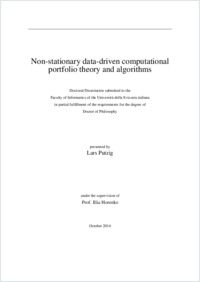Non-stationary data-driven computational portfolio theory and algorithms
- Putzig, Lars
- Horenko, Illia (Degree supervisor)
-
29.10.2014
101 p
Thèse de doctorat: Università della Svizzera italiana, 2014
Portfolio optimization
Utility optimization
Time series analysis
Non-stationary
Investment
Portfolio allocation
Model-free
Transaction cost
Market phases
English
The aim of the dissertation is the development of a data-driven portfolio optimization framework beyond standard assumptions. Investment decisions are either based on the opinion of a human expert, who evaluates information about companies, or on statistical models. The most famous methods based on statistics are the Markowitz portfolio model and utility maximization. All statistical methods assume certain knowledge over the underlying distribution of the returns, either by imposing Gaussianity, by expecting complete knowledge of the distribution or by inferring sufficiently good estimators of parameters. Yet in practice, all methods suffer from incomplete knowledge, small sample sizes and the problem that parameters might be varying over time. A new, model-free approach to the portfolio optimization problem allowing for time-varying dynamics in the price processes is presented. The methods proposed in this work are designed to solve the problem with less a-priori assumptions than standard methods, like assumptions on the distribution of the price processes or assumptions on time-invariant statistical properties. The new approach introduces two new parameters and a method to chose these based on principles of information theory. An analysis of different approaches to incorporate additional information is performed before a straightforward approach to the out-of-sample application is introduced. The structure of the numerical problem is obtained directly from the problem of portfolio optimization, resulting in a system of objective function and constraints known from non-stationary time series analysis. The incorporation of transaction costs allows to naturally obtain regularization that is normally included for numerical reasons. The applicability and the numerical feasibility of the method are demonstrated in a low-dimensional example in-sample and in a high-dimensional example in- and out-of-sample in an environment with mixed transaction costs. The performance of both examples is measured and compared to standard methods, as the Markowitz approach and to methods based on techniques to analyse non- stationary data, like Hidden Markov Models.
- Language
-
- English
- Classification
- Computer science and technology
- License
-
License undefined
- Identifiers
-
- RERO DOC 232867
- URN urn:nbn:ch:rero-006-113471
- ARK ark:/12658/srd1318639
- Persistent URL
- https://n2t.net/ark:/12658/srd1318639
Statistics
Document views: 305
File downloads:
- Texte intégral: 220
